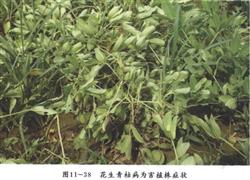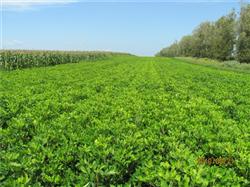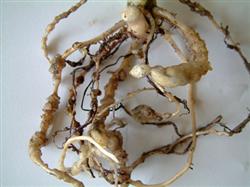Occurrence and control of peanut bacterial wilt

Peanut bacterial wilt, commonly known as "green disease", "dead seedling", "plague" and "dead vine", is an important disease in peanut producing areas. The incidence rate of general plots is 10%-25%, and the incidence of serious plots is more than 50%. Peanut bacterial wilt (Ralstonia solanacearum) is a typical vascular disease, which can occur in the whole growth period of peanut, but the most common disease is in flowering stage. The pathogen mainly infected the root, first made the main root tip discolor and soft rot, initially made the ducts and other tissues turn light brown, then dark brown, and developed from the root to the aboveground part to the top of the plant. Discoloration and necrosis of vascular bundles can be seen when the disease is cross-sectioned, and milky white turbid bacterial pus droplets can be seen by squeezing the disease root with hands. The symptoms of the diseased plants were not obvious at the initial stage, but began to appear after 3 or 4 days. The main performance was that the leaves opened late in the morning and closed early in the afternoon, and first showed water loss and wilting on the second leaf at the top of the main stem, and the lateral branch leaves were sagging. After 2 or 3 days, the whole plant withered, but the leaves remained light green. control methods: first, disease-resistant varieties should be selected, such as Luhua 3, Wanhua 2 and so on. The second is to implement the rotation of flood and drought. In recent years, we have generally adopted the rotation system of rice and peanut, which has basically controlled the occurrence of peanut bacterial wilt. Under the condition that there is no water source, it is best to use the method of rotation every two years. The third is to carry out chemical prevention and control. The peanut rosette stage and early flowering stage can be prevented and treated twice with 500 times solution of 5% bacteriological clear water agent or 500 times 800 times solution of 50% compound carbendazim suspension; or holes of 10 cm to 17 cm in diameter can be dug every 30 cm in peanut field, 3 ml 90% chlorinated bitterness can be injected into each hole, and the plastic film can be covered with solid topsoil, and the film can be removed after 7 days.
- Prev

What is the principle of fertilizing peanuts?
The main results are as follows: (1) Farm manure is the main and chemical fertilizer is the auxiliary. In China, peanuts are mostly planted in hilly areas, with thin soil layer and low fertility. Farm manure is mainly organic fertilizer, which is rich in nutrients, which can improve soil, fertilize and fertilize the soil for a long time. Chemical fertilizer is a quick-acting fertilizer, although it also contains the nutrients needed by peanuts, but with.
- Next

Skillful use of calcium Fertilizer to increase yield of Peanut
Peanut root-knot nematode disease is an important disease of peanuts, generally reducing yield by 2030%, serious cases up to 70,80%, or even no harvest. First, the symptom of this disease mainly harms the root, any part of peanut that can be buried (roots, pods, etc.) can be damaged by nematodes. Half a month after sowing, when the main root of peanut begins to grow, the line.
Related
- The first cup of black tea in spring, the flavor and history of tea gardens in Kenya, Africa
- The computer can not only choose potatoes, but also grow tea rice. AI will grow winter oolong tea champion.
- It is not only the inflated tea bitten by insects, but also engraved with the four seasons tea in Beipu.
- The Oriental Beauty Tea Festival in Zhuxian County takes the stage at the weekend to experience the plus-size feast of oil tea.
- & quot; Oriental Beauty Tea & Exploration of Emei in Hsinchu, the hometown of quot;
- The new variety of strawberry "Tainong 1" dessert is the first choice with mellow aroma. Crimson gorgeous
- History of Tea in Taiwan: from Wild Inner Mountain to Export Tea Garden
- Two types of Taiwan Oriental Beauty Black Tea won the British three-Star Award for Childhood Tea Xiang Zhang Jiaqi changed from pilot to champion tea maker.
- Banana species and varieties: the planting history of Taiwan Xianren banana and dwarf banana is long, is banana disease resistant?
- Coffee planting Technology: Qianjie Coffee from Seedling to harvesting

